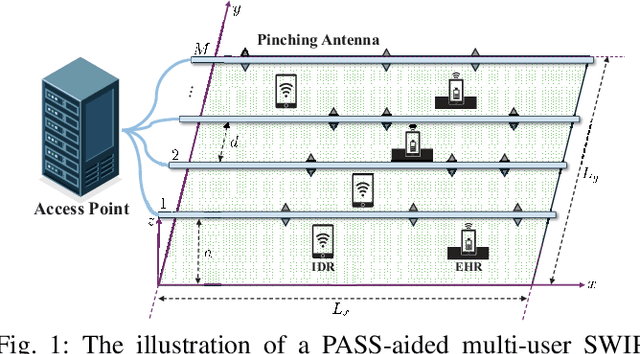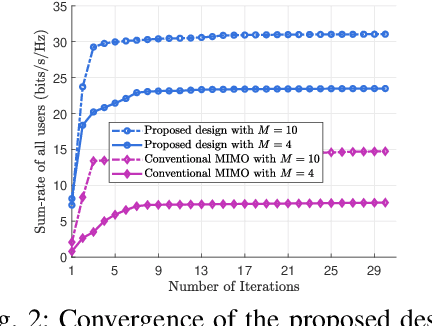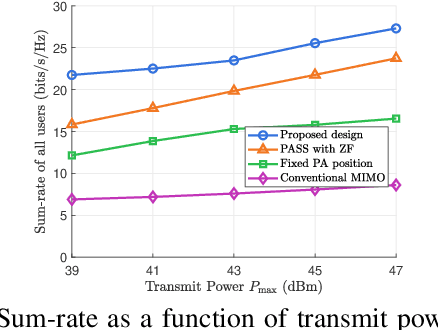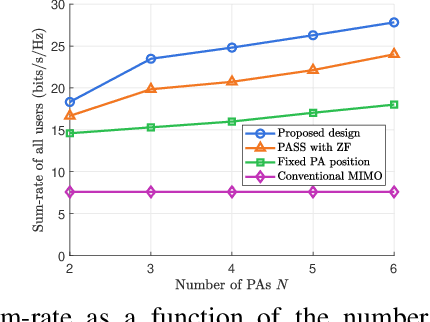H. Vincent Poor
Shitz
Adversary-Aware Private Inference over Wireless Channels
Oct 23, 2025Abstract:AI-based sensing at wireless edge devices has the potential to significantly enhance Artificial Intelligence (AI) applications, particularly for vision and perception tasks such as in autonomous driving and environmental monitoring. AI systems rely both on efficient model learning and inference. In the inference phase, features extracted from sensing data are utilized for prediction tasks (e.g., classification or regression). In edge networks, sensors and model servers are often not co-located, which requires communication of features. As sensitive personal data can be reconstructed by an adversary, transformation of the features are required to reduce the risk of privacy violations. While differential privacy mechanisms provide a means of protecting finite datasets, protection of individual features has not been addressed. In this paper, we propose a novel framework for privacy-preserving AI-based sensing, where devices apply transformations of extracted features before transmission to a model server.
Generalized Pinching-Antenna Systems: A Tutorial on Principles, Design Strategies, and Future Directions
Oct 15, 2025Abstract:Pinching-antenna systems have emerged as a novel and transformative flexible-antenna architecture for next-generation wireless networks. They offer unprecedented flexibility and spatial reconfigurability by enabling dynamic positioning and activation of radiating elements along a signal-guiding medium (e.g., dielectric waveguides), which is not possible with conventional fixed antenna systems. In this paper, we introduce the concept of generalized pinching antenna systems, which retain the core principle of creating localized radiation points on demand, but can be physically realized in a variety of settings. These include implementations based on dielectric waveguides, leaky coaxial cables, surface-wave guiding structures, and other types of media, employing different feeding methods and activation mechanisms (e.g., mechanical, electronic, or hybrid). Despite differences in their physical realizations, they all share the same inherent ability to form, reposition, or deactivate radiation sites as needed, enabling user-centric and dynamic coverage. We first describe the underlying physical mechanisms of representative generalized pinching-antenna realizations and their associated wireless channel models, highlighting their unique propagation and reconfigurability characteristics compared with conventional antennas. Then, we review several representative pinching-antenna system architectures, ranging from single- to multiple-waveguide configurations, and discuss advanced design strategies tailored to these flexible deployments. Furthermore, we examine their integration with emerging wireless technologies to enable synergistic, user-centric solutions. Finally, we identify key open research challenges and outline future directions, charting a pathway toward the practical deployment of generalized pinching antennas in next-generation wireless networks.
Spectral Graph Clustering under Differential Privacy: Balancing Privacy, Accuracy, and Efficiency
Oct 08, 2025Abstract:We study the problem of spectral graph clustering under edge differential privacy (DP). Specifically, we develop three mechanisms: (i) graph perturbation via randomized edge flipping combined with adjacency matrix shuffling, which enforces edge privacy while preserving key spectral properties of the graph. Importantly, shuffling considerably amplifies the guarantees: whereas flipping edges with a fixed probability alone provides only a constant epsilon edge DP guarantee as the number of nodes grows, the shuffled mechanism achieves (epsilon, delta) edge DP with parameters that tend to zero as the number of nodes increase; (ii) private graph projection with additive Gaussian noise in a lower-dimensional space to reduce dimensionality and computational complexity; and (iii) a noisy power iteration method that distributes Gaussian noise across iterations to ensure edge DP while maintaining convergence. Our analysis provides rigorous privacy guarantees and a precise characterization of the misclassification error rate. Experiments on synthetic and real-world networks validate our theoretical analysis and illustrate the practical privacy-utility trade-offs.
Joint Communication and Indoor Positioning Based on Visible Light in the Presence of Dimming
Aug 06, 2025Abstract:This paper proposes a joint communication and indoor positioning (JCP) system based on visible light communication (VLC) designed for high-precision indoor environments. The framework supports 2D and 3D positioning using received signal strength (RSS) from pilot transmissions, enhanced by the radical axis theorem to improve accuracy under measurement uncertainties. Communication is achieved using spatial modulation (SM) with M-ary pulse amplitude modulation (PAM), where data is conveyed through the modulation symbol and the active light-emitting diode (LED) index, improving spectral efficiency while maintaining low complexity. A pilot-aided least squares (LS) estimator is employed for joint channel and dimming coefficient estimation, enabling robust symbol detection in multipath environments characterized by both line-of-sight (LOS) and diffuse non-line-of-sight (NLOS) components, modeled using Rician fading. The proposed system incorporates a dimming control mechanism to meet lighting requirements while maintaining reliable communication and positioning performance. Simulation results demonstrate sub-centimeter localization accuracy at high signal-to-noise ratios (SNRs) and bit error rates (BERs) below 10^{-6} for low-order PAM schemes. Additionally, comparative analysis across user locations reveals that positioning and communication performance improve significantly near the geometric center of the LED layout. These findings validate the effectiveness of the proposed system for future 6G indoor networks requiring integrated localization and communication under practical channel conditions.
Optimizing Model Splitting and Device Task Assignment for Deceptive Signal Assisted Private Multi-hop Split Learning
Jul 09, 2025Abstract:In this paper, deceptive signal-assisted private split learning is investigated. In our model, several edge devices jointly perform collaborative training, and some eavesdroppers aim to collect the model and data information from devices. To prevent the eavesdroppers from collecting model and data information, a subset of devices can transmit deceptive signals. Therefore, it is necessary to determine the subset of devices used for deceptive signal transmission, the subset of model training devices, and the models assigned to each model training device. This problem is formulated as an optimization problem whose goal is to minimize the information leaked to eavesdroppers while meeting the model training energy consumption and delay constraints. To solve this problem, we propose a soft actor-critic deep reinforcement learning framework with intrinsic curiosity module and cross-attention (ICM-CA) that enables a centralized agent to determine the model training devices, the deceptive signal transmission devices, the transmit power, and sub-models assigned to each model training device without knowing the position and monitoring probability of eavesdroppers. The proposed method uses an ICM module to encourage the server to explore novel actions and states and a CA module to determine the importance of each historical state-action pair thus improving training efficiency. Simulation results demonstrate that the proposed method improves the convergence rate by up to 3x and reduces the information leaked to eavesdroppers by up to 13% compared to the traditional SAC algorithm.
An Integrated Sensing and Communication System for Time-Sensitive Targets with Random Arrivals
Jun 18, 2025Abstract:In 6G networks, integrated sensing and communication (ISAC) is envisioned as a key technology that enables wireless systems to perform joint sensing and communication using shared hardware, antennas and spectrum. ISAC designs facilitate emerging applications such as smart cities and autonomous driving. Such applications also demand ultra-reliable and low-latency communication (URLLC). Thus, an ISAC-enabled URLLC system can prioritize time-sensitive targets and ensure information delivery under strict latency and reliability constraints. We propose a bi-static MIMO ISAC system to detect the arrival of URLLC messages and prioritize their delivery. In this system, a base station (BS) communicates with a user equipment (UE) and a sensing receiver (SR) is deployed to collect echo signals reflected from a target of interest. The BS regularly transmits messages of enhanced mobile broadband (eMBB) services to the UE. During each eMBB transmission, if the SR senses the presence of a target of interest, it immediately triggers the transmission of an additional URLLC message. To reinforce URLLC transmissions, we propose a dirty-paper coding (DPC)-based technique that mitigates the interference of both eMBB and sensing signals. To decode the eMBB message, we consider two approaches for handling the URLLC interference: treating interference as noise and successive interference cancellation. For this system, we formulate the rate-reliability-detection trade-off in the finite blocklength (FBL) regime by evaluating the communication rate of the eMBB transmissions, the reliability of the URLLC transmissions and the probability of the target detection. Our numerical analysis show that our proposed DPC-based ISAC scheme significantly outperforms power-sharing and traditional time-sharing schemes. In particular, it achieves higher eMBB transmission rate while satisfying both URLLC and sensing constraints.
MIMO Pinching-Antenna-Aided SWIPT
Jun 07, 2025



Abstract:Pinching-antenna systems (PASS) have recently emerged as a promising technology for improving wireless communications by establishing or strengthening reliable line-of-sight (LoS) links by adjusting the positions of pinching antennas (PAs). Motivated by these benefits, we propose a novel PASS-aided multi-input multi-output (MIMO) system for simultaneous wireless information and power transfer (SWIPT), where the PASS are equipped with multiple waveguides to provide information transmission and wireless power transfer (WPT) for several multiple antenna information decoding receivers (IDRs), and energy harvesting receivers (EHRs), respectively. Based on the system, we consider maximizing the sum-rate of all IDRs while guaranteeing the minimum harvested energy of each EHR by jointly optimizing the pinching beamforming and the PA positions. To solve this highly non-convex problem, we iteratively optimize the pinching beamforming based on a weighted minimum mean-squared-error (WMMSE) method and update the PA positions with a Gauss-Seidel-based approach in an alternating optimization (AO) framework. Numerical results verify the significant superiority of the PASS compared with conventional designs.
Resource Allocation for Pinching-Antenna Systems: State-of-the-Art, Key Techniques and Open Issues
Jun 06, 2025Abstract:Pinching antennas have emerged as a promising technology for reconfiguring wireless propagation environments, particularly in high-frequency communication systems operating in the millimeter-wave and terahertz bands. By enabling dynamic activation at arbitrary positions along a dielectric waveguide, pinching antennas offer unprecedented channel reconfigurability and the ability to provide line-of-sight (LoS) links in scenarios with severe LoS blockages. The performance of pinching-antenna systems is highly dependent on the optimized placement of the pinching antennas, which must be jointly considered with traditional resource allocation (RA) variables -- including transmission power, time slots, and subcarriers. The resulting joint RA problems are typically non-convex with complex variable coupling, necessitating sophisticated optimization techniques. This article provides a comprehensive survey of existing RA algorithms designed for pinching-antenna systems, supported by numerical case studies that demonstrate their potential performance gains. Key challenges and open research problems are also identified to guide future developments in this emerging field.
Generative Diffusion Model Driven Massive Random Access in Massive MIMO Systems
May 18, 2025Abstract:Massive random access is an important technology for achieving ultra-massive connectivity in next-generation wireless communication systems. It aims to address key challenges during the initial access phase, including active user detection (AUD), channel estimation (CE), and data detection (DD). This paper examines massive access in massive multiple-input multiple-output (MIMO) systems, where deep learning is used to tackle the challenging AUD, CE, and DD functions. First, we introduce a Transformer-AUD scheme tailored for variable pilot-length access. This approach integrates pilot length information and a spatial correlation module into a Transformer-based detector, enabling a single model to generalize across various pilot lengths and antenna numbers. Next, we propose a generative diffusion model (GDM)-driven iterative CE and DD framework. The GDM employs a score function to capture the posterior distributions of massive MIMO channels and data symbols. Part of the score function is learned from the channel dataset via neural networks, while the remaining score component is derived in a closed form by applying the symbol prior constellation distribution and known transmission model. Utilizing these posterior scores, we design an asynchronous alternating CE and DD framework that employs a predictor-corrector sampling technique to iteratively generate channel estimation and data detection results during the reverse diffusion process. Simulation results demonstrate that our proposed approaches significantly outperform baseline methods with respect to AUD, CE, and DD.
Multi-Fidelity Bayesian Optimization for Nash Equilibria with Black-Box Utilities
May 16, 2025Abstract:Modern open and softwarized systems -- such as O-RAN telecom networks and cloud computing platforms -- host independently developed applications with distinct, and potentially conflicting, objectives. Coordinating the behavior of such applications to ensure stable system operation poses significant challenges, especially when each application's utility is accessible only via costly, black-box evaluations. In this paper, we consider a centralized optimization framework in which a system controller suggests joint configurations to multiple strategic players, representing different applications, with the goal of aligning their incentives toward a stable outcome. To model this interaction, we formulate a Stackelberg game in which the central optimizer lacks access to analytical utility functions and instead must learn them through sequential, multi-fidelity evaluations. To address this challenge, we propose MF-UCB-PNE, a novel multi-fidelity Bayesian optimization strategy that leverages a budget-constrained sampling process to approximate pure Nash equilibrium (PNE) solutions. MF-UCB-PNE systematically balances exploration across low-cost approximations with high-fidelity exploitation steps, enabling efficient convergence to incentive-compatible configurations. We provide theoretical and empirical insights into the trade-offs between query cost and equilibrium accuracy, demonstrating the effectiveness of MF-UCB-PNE in identifying effective equilibrium solutions under limited cost budgets.
 Add to Chrome
Add to Chrome Add to Firefox
Add to Firefox Add to Edge
Add to Edge